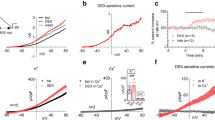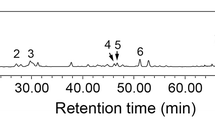Abstract
Voltage-gated sodium channels are crucial mediators of neuronal damage in ischemic and excitotoxicity disease models. Fenamates have been reported to have anti-inflammatory properties following a decrease in prostaglandin synthesis. Several researches showed that fenamates appear to be ion channel modulators and potential neuroprotectants. In this study, the neuroprotective effects of tolfenamic acid, flufenamic acid, and mefenamic acid were tested by glutamate-induced injury in SH-SY5Y cells. Following this, fenamates’ effects were examined on both the expression level and the function of hNav1.1 and hNav1.2, which were closely associated with neuroprotection, using Western blot and patch clamp. Finally, the effect of fenamates on the expression of apoptosis-related proteins in SH-SY5Y cells was examined. The results showed that both flufenamic acid and mefenamic acid exhibited neuroprotective effects against glutamate-induced injury in SH-SY5Y cells. They inhibited peak currents of both hNav1.1 and hNav1.2. However, fenamates exhibited decreased inhibitory effects on hNav1.1 when compared to hNav1.2. Correspondingly, the inhibitory effect of fenamates was found to be consistent with the level of neuroprotective effects in vitro. Fenamates inhibited glutamate-induced apoptosis through the modulation of the Bcl-2/Bax-dependent cell death pathways. Taken together, Nav1.2 might play a part in fenamates’ neuroprotection mechanism.
Graphic Abstract
Nav1.2 and NMDAR might take part in the neuroprotection mechanism of the fenamates. The fenamates inhibited glutamate-induced apoptosis through modulation of the Bcl-2/Bax-dependent cell death pathways.









Similar content being viewed by others
Abbreviations
- CNS:
-
Central nervous system
- VGSC:
-
Voltage-gated sodium channel
- NSAIDs:
-
Nonsteroidal anti-inflammatory drugs
- DRG:
-
Dorsal root ganglion
- ROS:
-
Reactive oxygen species
- MCAO:
-
Middle cerebral artery occlusion
- DMEM:
-
Dulbecco's modified Eagle medium
- IMDM:
-
Iscove's modified Dulbecco's medium
- CHO:
-
Chinese hamster ovary
- FBS:
-
Fetal bovine serum
- ATCC:
-
American Type Culture Collection
References
Chen Q, Olney JW, Lukasiewicz PD, Almli T, Romano C (1998) Fenamates protect neurons against ischemic and excitotoxic injury in chick embryo retina. Neurosci Lett 242:163–166
Daniels MJ, Rivers-Auty J, Schilling T, Spencer NG, Watremez W, Fasolino V, Booth SJ, White CS, Baldwin AG, Freeman S, Wong R, Latta C, Yu S, Jackson J, Fischer N, Koziel V, Pillot T, Bagnall J, Allan SM, Paszek P, Galea J, Harte MK, Eder C, Lawrence CB, Brough D (2016) Fenamate NSAIDs inhibit the NLRP3 inflammasome and protect against Alzheimer's disease in rodent models. Nat Commun 7:12504
Florio SK, Loh C, Huang SM, Iwamaye AE, Kitto KF, Fowler KW, Treiberg JA, Hayflick JS, Walker JM, Fairbanks CA, Lai Y (2009) Disruption of nNOS-PSD95 protein-protein interaction inhibits acute thermal hyperalgesia and chronic mechanical allodynia in rodents. Br J Pharmacol 158:494–506
Flower RJ (1974) Drugs which inhibit prostaglandin biosynthesis. Pharmacol Rev 26:33–67
Flower R, Gryglewski R, Herbaczyn′ ska-Cedro K, Vane JR (1972) Effects of anti-inflammatory drugs on prostaglandin biosynthesis. Nat New Biol 238(104):106
Greenwood IA, Large WA (1995) Comparison of the effects of fenamates on Ca-activated chloride and potassium currents in rabbit portal vein smooth muscle cells. Br J Pharmacol 116:2939–2948
Grover GJ, D’Alonzo AJ, Sleph PG, Dzwonczyk S, Hess TA, Darbenzio RB (1994) The cardioprotective and electrophysiological effects of cromakalim are attenuated by meclofenamate through a cyclooxygenase-independent mechanism. J Pharmacol Exp Ther 269:536–540
Han Z, Yang JL, Jiang SX, Hou ST, Zheng RY (2013) Fast, non-competitive and reversible inhibition of NMDA-activated currents by 2-BFI confers neuroprotection. PLoS ONE 8:e64894
Jiang H, Zeng B, Chen GL, Bot D, Eastmond S, Elsenussi SE, Atkin SL, Boa AN, Xu SZ (2012) Effect of non-steroidal anti-inflammatory drugs and new fenamate analogues on TRPC4 and TRPC5 channels. Biochem Pharmacol 83:923–931
Kahlig KM, Lepist I, Leung K, Rajamani S, George AL (2010) Ranolazine selectively blocks persistent current evoked by epilepsy-associated Nav1.1 mutations. Br J Pharmacol 161:1414–1426
Khansari PS, Halliwell RF (2009) Evidence for neuroprotection by the fenamate NSAID, mefenamic acid. Neurochem Int 55:683–688
Lee HM, Kim HI, Shin YK, Lee CS, Park M, Song JH (2003) Diclofenac inhibition of sodium currents in rat dorsal root ganglion neurons. Brain Res 992:120–127
Lo EH, Dalkara T, Moskowitz MA (2003) Mechanisms, challenges and opportunities in stroke. Nat Rev Neurosci 4:399–415
Lyden P, Wahlgren NG (2000) Mechanisms of action of neuroprotectants in stroke. J Stroke Cerebrovasc Dis 9:9–14
Olney JW (1978) Neurotoxicity of excitatory amino acid. In: McGeer E, Olney JW, McGeer P (eds) Kainic acid as a tool in neurobiology. Raven, New York, pp 95–121
Rothman SM (1984) Synaptic release of excitatory amino acid neurotransmitter mediates anoxic neuronal death. J Neurosci 4:1884–1891
Sandalon S, Könnecke B, Levkovitch-Verbin H, Simons M, Hein K, Sättler MB, Bähr M, Ofri R (2013) Functional and structural evaluation of lamotrigine treatment in rat models of acute and chronic ocular hypertension. Exp Eye Res 115:47–56
Sanger GJ, Bennett A (1979) Fenamates may antagonize the actions of prostaglandin endoperoxides in human myometrium. Br J Clin Pharmacol 8:479–482
Santos MS, Moreno AJ, Carvalho AP (1996) Relationships between ATP depletion, membrane potential, and the release of neurotransmitters in rat nerve terminals. An in vitro study under conditions that mimic anoxia, hypoglycemia, and ischemia. Stroke 27:941–950
Shi HS, Lai K, Yin XL, Liang M, Ye HB, Shi HB, Wang LY, Yin SK (2019) Ca2+-dependent recruitment of voltage-gated sodium channels underlies bilirubin-induced overexcitation and neurotoxicity. Cell Death Dis 10:774
Simon RP, Swan JH, Griffiths T, Meldrum BS (1984) Blockade of N-methyl-d-aspartate receptors may protect against ischemic damage in the brain. Science 226:850–852
Small DL, Morley P, Buchan AM (1999) Biology of ischemic cerebral cell death. Prog Cardiovasc Dis 42:185–207
Stevens M, Timmermans S, Bottelbergs A, Hendriks JJ, Brône B, Baes M, Tytgat J (2013) Block of a subset of sodium channels exacerbates experimental autoimmune encephalomyelitis. J Neuroimmunol 261:21–28
Sun JF, Xu YJ, Kong XH, Su Y, Wang ZY (2018) Fenamates inhibit human sodium channel Nav1.7 and Nav1.8. Neurosci Lett 696:67–73
Waxman SG (2008) Mechanisms of disease: sodium channels and neuroprotection in multiple sclerosis-current status. Nat Clin Pract Neurol 4:159–169
White MM, Aylwin M (1990) Niflumic and flufenamic acids are potent reversible blockers of Ca2+-activated Cl- channels in Xenopus oocytes. Mol Pharmacol 37:720–724
Wu QJ, Tymianski M (2018) Targeting NMDA receptors in stroke: new hope in neuroprotection. Mol Brain 11:15
Xu Y, Meng X, Hou X, Sun J, Kong X, Sun Y, Liu Z, Ma Y, Niu Y, Song Y, Cui Y, Zhao M, Zhang J (2017) A mutant of the Buthus martensii Karsch antitumor-analgesic peptide exhibits reduced inhibition to hNav1.4 and hNav1.5 channels while retaining analgesic activity. J Biol Chem 292:18270–18280
Yau HJ, Baranauskas G, Martina M (2010) Flufenamic acid decreases neuronal excitability through modulation of voltage-gated sodium channel gating. J Physiol 588:3869–3882
Zhang JM, Wang HK, Ye CQ, Ge W, Chen Y, Jiang ZL, Wu CP, Poo MM, Duan S (2003) ATP released by astrocytes mediates glutamatergic activity-dependent heterosynaptic suppression. Neuron 40:971–982
Zhao ZW, Fan XX, Song JJ, Xu M, Chen MJ, Tu JF, Wu FZ, Zhang DK, Liu L, Chen L, Ying XH, Ji JS (2017) ShRNA knock-down of CXCR7 inhibits tumour invasion and metastasis in hepatocellular carcinoma after transcatheter arterial chemoembolization. J Cell Mol Med 21:1989–1999
Acknowledgements
We gratefully acknowledge the financial support from the Innovation Team Project of the Department of Education of Liaoning Province (LT2015010) and the PhD Start-up Fund of Natural Science Foundation of Liaoning Province (2019-BS-231).
Author information
Authors and Affiliations
Contributions
All authors contributed to the study conception and design. JS, YX, and XK carried out electrophysiology studies. JS carried out MTT assay. JS, YX, and YS carried out Western blot experiments and Annexin V-FITC/PI analysis. YX and ZW conceived and designed the experiments. JS, MZ, and YX wrote this manuscript, and all authors commented on previous versions of the manuscript. All authors read and approved the final manuscript.
Corresponding authors
Ethics declarations
Ethical Approval
All applicable international, national, and/or institutional guidelines for the care and use of animals were followed.
Conflict of interest
The authors declare that they have no conflicts of interest.
Informed Consent
This article does not contain any studies with human participants performed by any of the authors.
Additional information
Publisher's Note
Springer Nature remains neutral with regard to jurisdictional claims in published maps and institutional affiliations.
Rights and permissions
About this article
Cite this article
Sun, JF., Zhao, MY., Xu, YJ. et al. Fenamates Inhibit Human Sodium Channel Nav1.2 and Protect Glutamate-Induced Injury in SH-SY5Y Cells. Cell Mol Neurobiol 40, 1405–1416 (2020). https://doi.org/10.1007/s10571-020-00826-1
Received:
Accepted:
Published:
Issue Date:
DOI: https://doi.org/10.1007/s10571-020-00826-1




